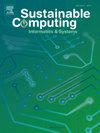Nearest data processing in GPU
IF 3.8
3区 计算机科学
Q1 COMPUTER SCIENCE, HARDWARE & ARCHITECTURE
引用次数: 0
Abstract
Memory wall is known as one of the most critical bottlenecks in processors, rooted in the long memory access delay. With the advent of emerging memory-intensive applications such as image processing, the memory wall problem has become even more critical. Near data processing (NDP) has been introduced as an astonishing solution where instead of moving data from the main memory, instructions are offloaded to the cores integrated with the main memory level. However, in NDP, instructions that are to be offloaded, are statically selected at the compilation time prior to run-time. In addition, NDP ignores the benefit of offloading instructions into the intermediate memory hierarchy levels. We propose Nearest Data Processing (NSDP) which introduces a hierarchical processing approach in GPU. In NSDP, each memory hierarchy level is equipped with processing cores capable of executing instructions. By analyzing the instruction status at run-time, NSDP dynamically decides whether an instruction should be offloaded to the next level of memory hierarchy or be processed at the current level. Depending on the decision, either data is moved upward to the processing core or the instruction is moved downward to the data storage unit. With this approach, the data movement rate has been reduced, on average, by 47 % over the baseline. Consequently, NSDP has been able to improve the system performance, on average, by 37 % and reduce the power consumption, on average, by 18 %.
GPU 中的最近数据处理
众所周知,内存墙是处理器中最关键的瓶颈之一,其根源在于内存访问延迟过长。随着图像处理等新兴内存密集型应用的出现,内存墙问题变得更加严重。近数据处理(NDP)作为一种惊人的解决方案已经问世,它不是从主存储器移动数据,而是将指令卸载到与主存储器级集成的内核上。然而,在 NDP 中,要卸载的指令是在运行前的编译时静态选择的。此外,NDP 忽略了将指令卸载到中间存储器层次的好处。我们提出的最近数据处理(NSDP)在 GPU 中引入了分层处理方法。在 NSDP 中,每个存储器层次都配备了能够执行指令的处理核心。通过分析运行时的指令状态,NSDP 动态决定指令是否应卸载到下一级内存层次,还是在当前层次进行处理。根据决定,要么将数据上移到处理核心,要么将指令下移到数据存储单元。采用这种方法后,数据移动速度比基准值平均降低了 47%。因此,NSDP 能够将系统性能平均提高 37%,将功耗平均降低 18%。
本文章由计算机程序翻译,如有差异,请以英文原文为准。
求助全文
约1分钟内获得全文
求助全文
来源期刊

Sustainable Computing-Informatics & Systems
COMPUTER SCIENCE, HARDWARE & ARCHITECTUREC-COMPUTER SCIENCE, INFORMATION SYSTEMS
CiteScore
10.70
自引率
4.40%
发文量
142
期刊介绍:
Sustainable computing is a rapidly expanding research area spanning the fields of computer science and engineering, electrical engineering as well as other engineering disciplines. The aim of Sustainable Computing: Informatics and Systems (SUSCOM) is to publish the myriad research findings related to energy-aware and thermal-aware management of computing resource. Equally important is a spectrum of related research issues such as applications of computing that can have ecological and societal impacts. SUSCOM publishes original and timely research papers and survey articles in current areas of power, energy, temperature, and environment related research areas of current importance to readers. SUSCOM has an editorial board comprising prominent researchers from around the world and selects competitively evaluated peer-reviewed papers.
 求助内容:
求助内容: 应助结果提醒方式:
应助结果提醒方式:


